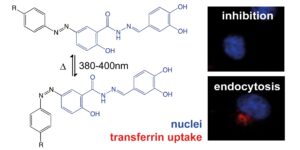
A way to understand how a cellular process work is by perturbing the activity of one key component of the system and observing how the process is affected. Most tools to achieve this “perturbation” are based on genetic approaches that interfere with the action of a protein or on the local administration of compounds. However, none of these approaches are suitable when investigating transient or irreversible events, as in the case of endocytosis, because it is difficult or impossible to control the protein dynamics, spatial location and timing of the activity. These limitations can also affect the efficacy and specificity of drugs used in pharmacotherapy.
Now, the “Nanoprobes and nanoswitches” group from IBEC lead by ICREA Research Professor Pau Gorostiza in collaboration with IQAC-CSIC, IPMC, IRB, IDIBELL, UB and UAB, publish in the journal Chemical Science a work where they develop the first photoswitchable small-molecule inhibitors of endocytosis: the dynazos. These molecules called dynazos are able to inhibit dynamin, a key protein in endocytosis, under non-illuminated conditions. Oppositely, by applying visible light, dynazos are inactivated as dynamin inhibitors and endocytosis can take place. Endocytosis is a mechanism used by all eukaryotic cells to internalize extracellular material and regulates key physiological processes as the uptake of nutrients and growth factors. Moreover, it also constitutes the entry pathway of a variety of pathogens. The use of dynazos will allow to precisely control the spatial location and dynamics of this strategic cellular process.
We have combined the pharmacological properties of the dynamin inhibitor dynasore with the photochromic properties of an azobenzene group, one of the best studied light-sensitive (photoswitchable) molecules.
Dr. Núria Camarero,
first co-author of the work.
Dynazos: the first inhibitors of endocytosis controlled by light
Researchers have used rational design to obtain the first light-regulated small-molecule inhibitor of endocytosis by a stepwise design to control dynamin. They characterized in detail the photochrome properties of dynazos under different light spectra and transient absorption spectroscopy and have obtained molecules that respond to violet visible light, what minimizes the potential negative effects of using UV light in living systems. Also, the biological activity of dynazos, at micromolar concentrations, was confirmed by confocal fluorescence microscopy, flow cytometry and Total Internal Reflection Microscopy (TIRFM) using different cell lines.
The newly developed tool, that allows to turn on and off remotely and reversibly the biological activity of dynamin, will certainly be very relevant to decipher the role of endocytosis in cellular processes as cell growth, differentiation, motility and modulation of transmembrane receptor signalling and synaptic transmission, among others. Endocytic processes also can be targeted to prevent infections, avoiding the entering of pathogens, or to intentionally kill cells by the uptake of toxic compounds.
Dynazos technology opens the doors to use light as the external trigger to control drug’s pharmacologic activity affecting endocytosis processes with high spatiotemporal resolution.
Professor Pau Gorostiza,
lead author of the work.
Reference article: Núria Camarero, Ana Trapero, Ariadna Pérez-Jiménez, Eric Macia, Alexandre Gomila-Juaneda, Andrés Martín-Quirós, Laura Nevola, Artur Llobet, Amadeu Llebaria, Jordi Hernando, Ernest Giralt, and Pau Gorostiza. Photoswitchable dynasore analogs to control endocytosis with light. Chem. Sci., 2020.
This work was done in collaboration with: Institute for Advanced Chemistry of Catalonia (IQAC-CSIC), Institut de Pharmacologie Moléculaire et Cellulaire (IPMC), Institute for Research in Biomedicine (IRB Barcelona), Bellvitge Biomedical Research Institute (IDIBELL), Departament de Química, Universitat Autònoma de Barcelona (UAB), Universitat de Barcelona (UB). The “Nanoprobes and nanoswitches” group is part of the CIBER-BBN network.





